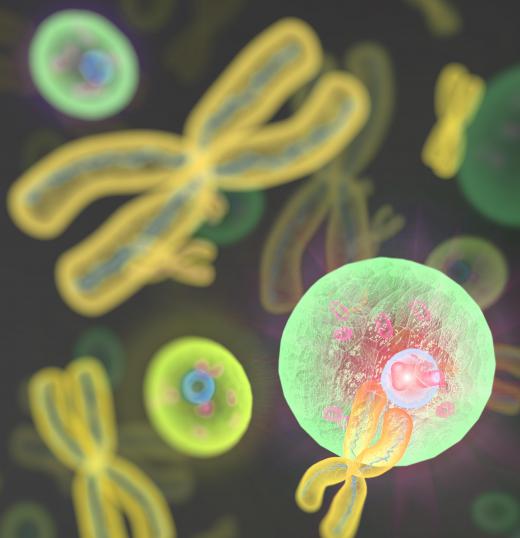What Is Heterochromatin?
Heterochromatin is a form of tightly-coiled chromosomal material that carries genes, and is considered to be largely inert genetically. It exists in two forms — constitutive and facultative heterochromatin. Constitutive heterochromatin is considered to be fixed in both form and function, and is found on the 1-, 9-, 16-, and Y-chromosomes, or typically locations like telomeres at the end of chromosomes. Facultative heterochromatin can change to a normal euchromatic condition, which comprises the bulk of genetically active material in the human body, and is found on inactive X-chromosomes.
Where heterochromatin formation is present, it usually represses the transcription of genetic information in itself or nearby chromatin regions, and this effect on gene expression is known as position effect variegation. The reason that heterochromatin formation prevents gene expression has been narrowed down in research to one of three causes. Heterochromatin protein can affect regions of nearby normal chromatin by repressing their ability at gene expression, or it can reside in regions where transcription is normally excluded anyway, such as in the chromocenter. The third method of repression doesn't apply to human genetic coding and instead is a limiting factor on gene expression in some insect species that have been studied for the effect, such as fruit flies.

Position effect variegation has now been established by science to be a condition in all eukaryote species, including yeast and every other life form except bacteria, some blue-green algae, and other primitive organisms. In mammalian organisms, heterochromatin is concentrated in the centromere, or central structure of a chromosome where the two chromatids are held together to form an X-shape. It is also located at the telomeres, or ends of chromosomal segments, of deoxyribonucleic acid (DNA).

At the centromere location, heterochromatin is a form of satellite DNA, which is a string of short, repetitive nucleotide sequences. Normally, satellite DNA is not involved in transcription as it is not in this case. It has also been known to be a highly mutable form of DNA prone to cancerous effects, but, in this case, centromeric heterochromatin is a stable and protective feature of the chromosome. The location appears to play a primarily structural or architectural role by serving as a binding medium for the kinetchore, which are the locations on either side of a chromosome centromere where spindle fibers are attached during the process of cell division.
The presence of heterochromatin in the body may have direct correlation to the aging process. It was once believed that locations for this chromosomal material were established in the early development of an organism and maintained throughout the life cycle. Research from the Geron Corporation now indicates that concentrations decline as an organism ages, and this has been seen in both yeast and mice studies where heterochromatin's ability to suppress gene expression gradually fades over time. As gene expression increases in these regions, it may contribute to mutations and degenerative conditions associated with aging.
AS FEATURED ON:
AS FEATURED ON:












Discuss this Article
Post your comments